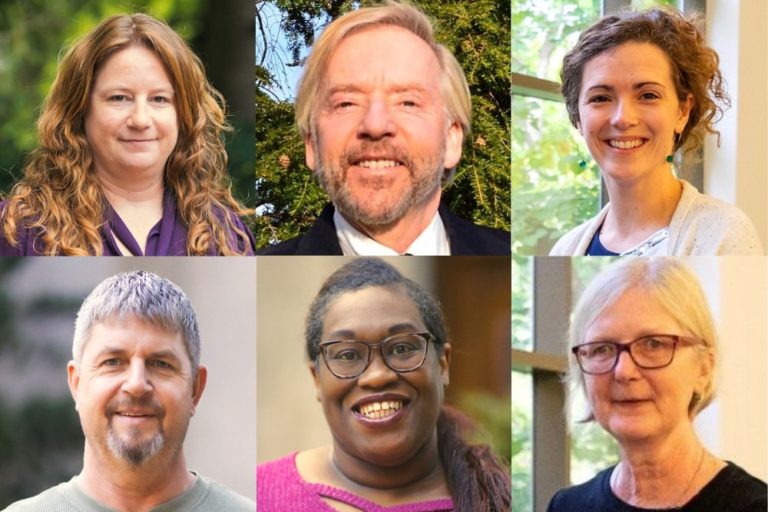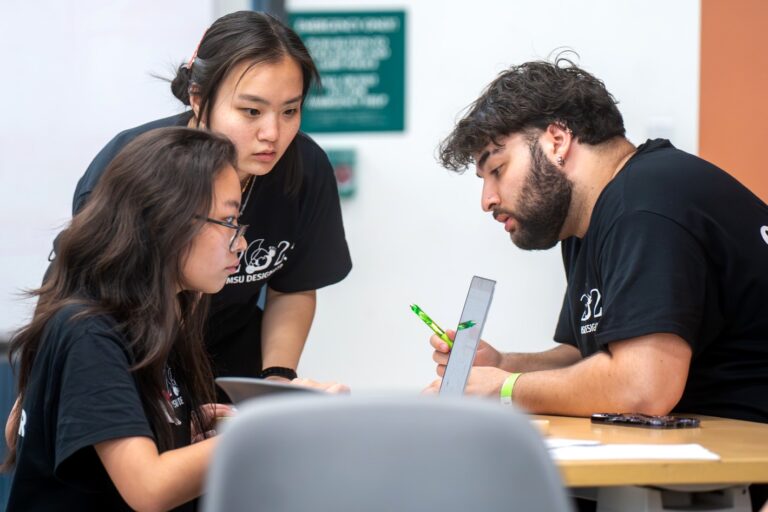The road to a career in the automotive industry sometimes takes twists and turns.
But looking in the rearview mirror, several alumnae of MSU’s College of Arts & Letters say their journeys were well worth the ride as they work to advance the world of mobility.
While many STEM graduates chart paths to the automotive industry, students of the liberal arts also have found seats at the table. Individuals with artistic skills, or who are well-versed in human behavior and context, are frequently recruited to help manufacturers design and strategize for current and future customers. Women, too, have discovered evolving and increasing opportunities as diversity and inclusion influence the direction of the industry.

Taylor Varner is among the MSU liberal arts graduates who have pursued careers in automotive. The 2013 Apparel and Textile Design graduate works as a Design Quality Engineer for Tesla in Fremont, California. Before that, she was employed with Toyota. A recruiter contacted her for each post, remarking that her liberal arts education made her a sought-after candidate.
Varner never imagined her dream job would manifest in the automotive industry, or that being a woman affected any opportunity.
My advice to anyone is to think outside of your major or field of study and see how it could apply to a position or career that interests you. I’m surprised on a daily basis how much I pull from my creative side.
Taylor Varner, Design Quality Engineer for Tesla
“I’ve seen many women advancing and getting hired in the automotive sector,” she said. “My advice to anyone is to think outside of your major or field of study and see how it could apply to a position or career that interests you. I’m surprised on a daily basis how much I pull from my creative side.”
Designing for Passions
Raised by Spartans, Varner always knew she would attend MSU. What she didn’t realize was that her passion for fashion would lead to a challenging career designing the look, feel, and perception of current and future vehicles.
Varner said she draws most every day on the skills she fine-tuned at MSU as she designs interior and exterior features like seat trim consoles, supercharger cables, and more. Evaluating color palettes, comparing different materials, and examining how parts and pieces work together to meet premium appearance standards are all in a day’s work.

“At MSU, there was a lot of creative freedom being an art student,” she said. “We were always encouraged to find new ways to present something viewed as normal or typical. In my current role, I’m expected to draw on that mindset, to think outside the box, and use my creative momentum to help guide our team to create the best product value.”
Liberal arts graduate Kate Whalen also came to her automotive career through an unexpected path. While her parents had both worked in the automotive sector for decades, Whalen wanted to veer from their footsteps. Michigan State, she said, gave her that opportunity and allowed her to check out the range of possibility within the liberal arts.

Whalen applied to Michigan State University with neuroscience as her field of study, but later shifted to economics. Her other passion was along the fashion route, specifically related to swimwear, which she later turned into a small business. Unsure about what to settle on as a major, she worked with an advisor, scrolled through a list of majors, and landed on Experience Architecture (XA), an interdisciplinary bachelor of arts program.
“I switched my major and never looked back,” Whalen said. “I wanted to deeply understand complex problems and pain points associated with experiences, and figure out how to improve them for people. I have a natural lens that is human-centered, so it was a good fit.”
Our goal is to create a future where mobility, autonomy, and connectivity are more flexible, mindful, and empowering. It’s exciting to be working on experiences and products that are driving revolution of mobility.
Kate Whalen, Ford College Graduate program
In 2018, the summer of her junior year, Whalen interned at Ford Motor Company in metro Detroit. She was placed in the human-centered area, or HCD. A few months later after returning to campus, she was offered a job and started the three-year Ford College Graduate (FCG) program shortly after she graduated in July 2019.
Today, Whalen is doing rotations between human-centered product design, global strategic research, and customer experience as she works within the field of mobility. At the end of the FCG program, she’ll focus on one area, depending on which best aligns with her skills and interests.

“My work is all about maintaining empathy, curiosity, and optimism while being collaborative. We’re exploring new services, new systems, and new experiences that are different than what society is traditionally used to,” she said. “Our goal is to create a future where mobility, autonomy, and connectivity are more flexible, mindful, and empowering. It’s exciting to be working on experiences and products that are driving revolution of mobility.”
Whalen is optimistic that the perception of automotive being a male-dominated field has diminished as more women with diverse skills enter the industry. In some ways, she says, the pandemic has helped move the needle on diversity and inclusion as more industries hire employees who live anywhere.
“I step into my virtual office and it is becoming far from a traditionally male-dominated environment,” she said. “There are women everywhere you look, and I love it.”
Answering the Future
Whalen said she never pictured the shape of her career and credits MSU’s forward-thinking curriculum and faculty as the reason she found her path.
“The collaborative nature of the XA curriculum prepped me for the diversity of projects and teams I come across every day in the workplace,” she said. “I rarely do anything alone in my work, so having learned how to collaborate in the classroom was extremely beneficial.”
Katie Jingozian agrees that MSU set her course toward becoming a Customer Knowledge and Strategy Pathfinder at Ford Motor Company. As a college freshman, she was undecided, but after working with advisors to combine her interests in psychology and art, she arrived at studying Apparel and Textile Design.

Graduating in 2010, Jingozian moved to New York and built a career as a designer for Victoria’s Secret and Danielle Nicole Handbags. In time, she went into leadership and secured a post as VP of Design and Merchandising at Gina Group LLC.
“But I realized that only seven years after graduating I had accomplished all my career goals,” she said. “I wanted to take on a new challenge and that brought me to automotive.”
Jingozian said the automotive industry presented the chance to integrate her design thinking and acumen with marketing, technology, and business strategy. She also welcomed the challenge of entering a field that was a bit out of her comfort zone.
“When people think of automotive, they tend to think really traditional — along the lines of math and science,” she said. “I had never really thought of going into automotive, but I discovered a lot of growth potential, particularly as companies are starting to shift the narrative of what vehicles can do.”
We’re looking at how people move around, how they feel about world-changing events and each other, and how we implement our vehicles to address those types of things. It’s interesting when you can apply your artistry and creativity on a scale that can change the world.
Kate Jingozian, Customer Knowledge and Strategy Pathfinder for Ford Motor Company
Jingozian quickly embraced the creativity and innovation involved in her job. She was inspired, too, by women in top leadership posts, many who became role models and mentors.
“I have learned a lot about having confidence in your choices, knowing your worth, and showing grace and empathy when you are empowered as a leader,” she said. “As a woman at Ford, I have always felt empowered, supported, and advocated for by my colleagues.”.
Jingozian describes her work as helping to translate world context into design language or actionable strategy — or essentially, being a futurist. It’s a career, she said, that was made possible by the ability to think, to explore, and arrive at solutions — all things she learned via her liberal arts degree from MSU.
“We’re looking at how people move around, how they feel about world-changing events and each other, and how we implement our vehicles to address those types of things,” she said of her profession. “It’s interesting when you can apply your artistry and creativity on a scale that can change the world.”


